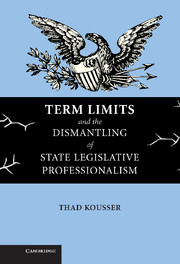Book contents
- Frontmatter
- Contents
- List of Figures and Tables
- Acknowledgments
- PART I THE MANY DESIGNS OF AMERICAN STATE LEGISLATURES
- PART II HOW DESIGN AFFECTS A LEGISLATURE'S FORM
- 3 The Stability of Leadership: How Long Does “First among Equals” Last?
- 4 The Role of Committees: Independent Actors or Agents?
- 5 Patterns in Legislative Achievement
- PART III HOW DESIGN AFFECTS A LEGISLATURE'S FUNCTION
- Appendix to Chapter 3
- Appendix to Chapter 4
- Appendix to Chapter 5
- Appendix to Chapter 6
- Appendix to Chapter 7
- References
- Index
3 - The Stability of Leadership: How Long Does “First among Equals” Last?
Published online by Cambridge University Press: 06 January 2010
- Frontmatter
- Contents
- List of Figures and Tables
- Acknowledgments
- PART I THE MANY DESIGNS OF AMERICAN STATE LEGISLATURES
- PART II HOW DESIGN AFFECTS A LEGISLATURE'S FORM
- 3 The Stability of Leadership: How Long Does “First among Equals” Last?
- 4 The Role of Committees: Independent Actors or Agents?
- 5 Patterns in Legislative Achievement
- PART III HOW DESIGN AFFECTS A LEGISLATURE'S FUNCTION
- Appendix to Chapter 3
- Appendix to Chapter 4
- Appendix to Chapter 5
- Appendix to Chapter 6
- Appendix to Chapter 7
- References
- Index
Summary
A definition of parliaments that has been applied to legislatures explains that “their members are formally equal to each other in status, distinguishing parliaments from hierarchically ordered organizations.” This highlights a key difference between representative bodies and other branches of government and sets forth an ideal of how they should operate.
In the everyday operation of legislatures, this ideal is rarely realized. Some members are first among equals. The status of a house's leader is manifestly higher than that of a rank-and-file member, with the leader granted informal powers, parliamentary privileges, additional staff assistance, and perhaps even a higher salary. When this position of advantage does not rotate among members, it may deliver a huge share of state projects to the leader's district, benefit some particular interest within a district, or give the ideological leanings of a district or its representative great weight. What makes duly elected legislators give up power to one of their own for a session, a decade, or longer?
I search for an answer to this question by testing a theory about when leadership transitions will occur in American statehouses. Long reigns by top leaders do not mark a legislature as transformative or as arenas, in Polsby's (1975) terminology. Yet the notion that a legislature's internal processes might be important in transforming its outputs focuses attention on the wiring diagram within a house, including the stability of its leaders. State legislative leaders typically face elections within their caucus or house at the beginning of every session.
- Type
- Chapter
- Information
- Publisher: Cambridge University PressPrint publication year: 2004



